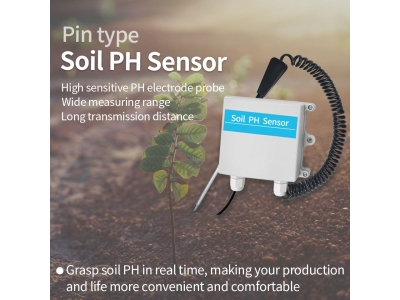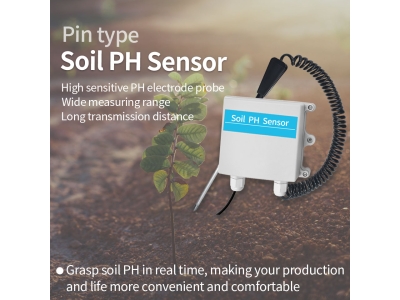Agriculture is a critical industry, providing food and resources to sustain our growing global population. However, the traditional farming methods face challenges related to resource management, including water consumption, fertilizer use, and soil health. To address these issues, innovative technologies have emerged, such as soil sensor technology, which revolutionizes agriculture by optimizing resource efficiency and enhancing crop yield. This article explores the significance of soil sensor technology in modern agriculture, its components, applications, and the transformative impact it has on resource management and sustainable farming practices.
The Role of Soil Sensor Technology:
1.1. Real-time Data Collection: Soil sensors provide real-time data on various soil properties, including moisture levels, temperature, pH, nutrient content, and salinity. This data is invaluable for farmers to make informed decisions about irrigation, fertilization, and other agronomic practices, ensuring optimal resource allocation.
1.2. Precision Farming: Soil sensor technology enables precision agriculture, where farmers can customize their practices based on site-specific conditions. By monitoring soil parameters accurately, farmers can apply inputs precisely, reducing waste, and increasing the efficiency of resource utilization.
1.3. Early Problem Detection: Soil sensors detect early signs of plant stress or nutrient deficiencies, allowing farmers to intervene promptly. Early problem detection helps prevent crop losses, optimize yield potential, and reduce the need for excessive pesticide or fertilizer application.
1.4. Data Integration and Analysis: Soil sensor technology facilitates the integration and analysis of soil data with other agricultural data sets, such as weather patterns and crop growth models. This integration provides a holistic view of the farm's ecosystem, enabling better decision-making and proactive management strategies.

Components of Soil Sensor Technology:
2.1. Soil Moisture Sensors: These sensors measure the amount of moisture present in the soil. They can be installed at different depths to monitor water availability at various root zones. Soil moisture sensors provide essential data for irrigation scheduling and optimizing water use efficiency.
2.2. Soil Temperature Sensors: Temperature sensors monitor soil temperature, which influences seed germination, root growth, nutrient availability, and microbial activity. By understanding soil temperature patterns, farmers can adjust planting schedules and maximize crop productivity.
2.3. Nutrient Sensors: These sensors measure the nutrient levels in the soil, including nitrogen, phosphorus, potassium, and other essential elements. Nutrient sensors help farmers determine the precise fertilizer requirements of crops, minimizing excess application and potential environmental pollution.
2.4. pH Sensors: pH sensors measure the acidity or alkalinity of the soil, which affects nutrient availability and microbial activity. By monitoring soil pH, farmers can adjust soil amendments and pH-related inputs to optimize crop growth and yield potential.
2.5. Data Loggers and Connectivity: Soil sensors are often connected to data loggers and wireless networks, enabling continuous data collection and transmission. This connectivity ensures real-time monitoring and provides farmers with convenient access to soil health information.
Transformative Impact on Resource Efficiency and Crop Yield:
3.1. Water Management: Soil sensor technology offers precise data on soil moisture levels, allowing farmers to optimize irrigation schedules and reduce water consumption. This technology helps avoid over-irrigation, waterlogging, and excessive evapotranspiration, enhancing water use efficiency and saving valuable resources.
3.2. Fertilizer Optimization: By monitoring nutrient levels in the soil, farmers can precisely apply fertilizers according to crop requirements. Avoiding under or over-fertilization minimizes nutrient wastage, reduces environmental impact, and improves nutrient uptake efficiency, leading to healthier plants and higher crop yields.
3.3. Energy Conservation: Soil sensor technology eliminates the need for manual soil sampling and laboratory analysis, reducing labor and energy costs associated with traditional soil testing methods. Additionally, it enables farmers to automate irrigation systems, optimizing energy consumption and reducing carbon emissions.
3.4. Soil Health Improvement: Continuous monitoring of soil parameters allows farmers to identify soil health issues promptly. By addressing these issues, such as nutrient imbalances or pH fluctuations, farmers can implement targeted soil management practices, improving soil health and enhancing long-term fertility.
3.5. Yield Optimization: Soil sensor technology empowers farmers to make data-driven decisions, leading to optimized crop yields. By fine-tuning irrigation, fertilization, and other agronomic practices based on real-time soil data, farmers can maximize the potential of their land, ensuring sustainable food production.
Advancements in Soil Sensor Technology:
4.1. Wireless Sensor Networks: Wireless sensor networks enable seamless communication among multiple soil sensors across vast agricultural landscapes. This technology improves data collection efficiency, expands coverage, and enhances the scalability of soil monitoring systems.
4.2. Improved Sensor Accuracy and Durability: Technological advancements have led to the development of more accurate and durable sensors. Enhanced sensor designs, materials, and calibration techniques ensure reliable and consistent data collection in diverse soil conditions and climates.
4.3. Data Analytics and Decision Support Systems: Advanced data analytics techniques, such as machine learning and artificial intelligence, help analyze large volumes of soil data collected from sensors. Decision support systems provide farmers with actionable insights, recommendations, and customized management plans based on the analyzed data.
4.4. Integration with IoT and Farm Management Software: Soil sensor technology can be integrated with Internet of Things (IoT) platforms and farm management software. This integration streamlines data management, facilitates remote monitoring, and enables seamless integration with other smart farming technologies.
4.5. Sensor Miniaturization and Cost Reduction: Ongoing research efforts aim to miniaturize soil sensors while maintaining their accuracy and functionality. Smaller and more affordable sensors will enable widespread adoption, particularly among smallholder farmers and resource-limited agricultural systems.
Future Directions and Challenges:
Soil sensor technology holds immense potential for sustainable agriculture, but certain challenges need to be addressed:
5.1. Education and Awareness: Farmers require knowledge and training on the use and interpretation of soil sensor data. Educational programs and awareness campaigns can help bridge the knowledge gap and promote the adoption of this technology.
5.2. Data Standardization and Interoperability: Ensuring data compatibility and interoperability among different sensor systems and software platforms is crucial for effective data sharing and integration. Standardization efforts must be undertaken to enable seamless communication and collaboration among stakeholders.
5.3. Cost-effectiveness and Affordability: Although the cost of soil sensors has reduced over time, affordability remains a concern, particularly for small-scale farmers. Continued research and development efforts should focus on reducing costs, increasing durability, and developing low-cost alternatives.
5.4. Calibration and Maintenance: Regular sensor calibration and maintenance are essential for accurate and reliable data collection. Farmer training programs should emphasize the importance of sensor calibration and provide guidance on maintenance protocols.
5.5. Scaling Up and Adoption: While soil sensor technology has gained traction in many developed regions, its adoption in resource-limited settings and smallholder farming systems needs to be encouraged. Financial incentives, capacity-building programs, and supportive policies can promote widespread adoption.
Conclusion:
Soil sensor technology is revolutionizing agriculture by enhancing resource efficiency, improving crop yield, and promoting sustainable farming practices. By providing real-time data on soil parameters, soil sensors enable precision farming, optimize resource allocation, and facilitate proactive management strategies. This technology has transformative impacts on water management, fertilizer optimization, energy conservation, soil health improvement, and crop yield optimization. Advancements in wireless sensor networks, improved sensor accuracy, data analytics, and integration with other smart farming technologies further enhance the capabilities of soil sensor technology. Addressing challenges related to education, data standardization, affordability, calibration, and adoption will maximize the benefits of this technology for farmers worldwide. With continued innovation, investment, and collaborative efforts, soil sensor technology holds great promise in building resilient and sustainable agricultural systems for the future.






